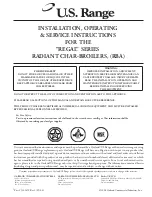
Part # 1382692 Rev 2 (09/04)
Page 5
INSTALLATION Continued
Air movement should be checked during installation.
Strong exhaust fans in the hood or in the overall air
conditioning system can produce a slight vacuum in the
room and/or cause air drafts. These can interfere with
pilot or burner performance and can be hard to diagnose.
If pilot or burner outage problems persist, make-up air
openings or baffles may have to be provided in the
room. If pilot/burner outage problems persist make-up
air openings or baffles may have to be provided in the
room.
Standards
Installation must be planned in accordance with all
applicable state and local codes, taking into account
the following standards (or latest edition):
Grease Extractor ANSI/NFPA 96-1992
Power Ventilators ANSI/NFPA 96-1987
Filter Unit ANSI/NFPA 96-1987
Smoke Detectors ANSI/NFPA 728-1986. CAN/
ULC 8553-1986
Fire Extinguisher (C02) ANSI/NFPA 12-1989
This section is not intended to be complete and other
nationally recognized standards may be appropriate.
Gas Supply
1. Installation of the equipment should be made by a
licensed plumber.
2. A gas shut-off valve must be installed in the gas
supply line ahead or the appliance for safety and for
ease of future service.
3. A gas pressure regulator must be installed at the
appliance prior to connecting the equipment to the
gas line. Failure to install a regulator will void the
equipment warranty.
NOTE: The gas supply (service) line must be the same
size or greater than the inlet line of the appliance. U.S.
Range “Regal” char-broilers use a 3/4” NPT inlet. Sealant
on all pipe joints must be resistive to LP gas.
To convert to propane or natural gas, contact a certified
service agency.
National Code Requirements For Gas Supply
Safe and satisfactory operation of your equipment
depends, to a great extent, on its proper installation.
Installation must conform to local codes or, in the absence
of local codes with the National Fuel code, ANSI Z223.1,
Natural Gas Installation Code, CAN/CGA-B149.1, or
the Propane Installation Code, CAN/CGA-B149.2, as
applicable, including:
1. The appliance and its individual shutoff valve must
be disconnected from the gas supply piping system
during any pressure testing of that system at test
pressures in excess of 1/2 psi (3.45 kPa).
2. The appliance must be isolated from the gas supply
piping system by closing its individual manual
shutoff valve during any pressure testing of the gas
supply piping system at test pressures equal to or
less than 1/2 psi (3.45 kPa)
Manual Shut-Off Valve
This installer-supplied valve must be installed in the gas
service line ahead of the appliance and regulator in the
gas stream and in a position where it can be reached
quickly in the event of an emergency.
Pressure Regulator
All commercial cooking equipment must have a pressure
regulator on the incoming service line for safe and
efficient operation. The pressure regulator installed must
be listed by a nationally recognized agency. Line service
pressure may fluctuate with local demand.
All “Regal” char-broilers must be installed with the
included gas pressure regulator.
Regulators are adjusted at the factory for 5” WC (natural
gas) or 10” WC (LP gas) depending on the customer’s
ordering instructions.
Summary of Contents for "REGAL" SERIES
Page 9: ...Part 1382692 Rev 2 09 04 Page 9 NOTES...
Page 10: ...Part 1382692 Rev 2 09 04 Page 10 NOTES...
Page 11: ...Part 1382692 Rev 2 09 04 Page 11 NOTES...
Page 12: ......






























